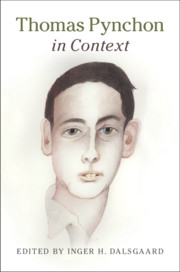Book contents
- Thomas Pynchon in Context
- Thomas Pynchon in Context
- Copyright page
- Contents
- Contributors
- Abbreviations
- Chronology
- Introduction
- Part I Times and Places
- Part II Culture, Politics, and Society
- Chapter 14 Family
- Chapter 15 Sex and Gender
- Chapter 16 Humor
- Chapter 17 Popular Culture
- Chapter 18 Music and Sound
- Chapter 19 Film and Television
- Chapter 20 Real Estate and the Internet
- Chapter 21 Politics and Counterculture
- Chapter 22 Drugs and Hippies
- Chapter 23 Ecology and the Environment
- Chapter 24 Capitalism and Class
- Chapter 25 War and Power
- Chapter 26 Conspiracy and Paranoia
- Chapter 27 Terror and Anarchy
- Chapter 28 Science and Technology
- Chapter 29 Mathematics
- Chapter 30 Time and Relativity
- Chapter 31 Philosophy
- Chapter 32 Religion and Spirituality
- Chapter 33 Death and Afterlife
- Part III Approaches and Readings
- Further Reading
- Index
Chapter 27 - Terror and Anarchy
from Part II - Culture, Politics, and Society
Published online by Cambridge University Press: 31 May 2019
- Thomas Pynchon in Context
- Thomas Pynchon in Context
- Copyright page
- Contents
- Contributors
- Abbreviations
- Chronology
- Introduction
- Part I Times and Places
- Part II Culture, Politics, and Society
- Chapter 14 Family
- Chapter 15 Sex and Gender
- Chapter 16 Humor
- Chapter 17 Popular Culture
- Chapter 18 Music and Sound
- Chapter 19 Film and Television
- Chapter 20 Real Estate and the Internet
- Chapter 21 Politics and Counterculture
- Chapter 22 Drugs and Hippies
- Chapter 23 Ecology and the Environment
- Chapter 24 Capitalism and Class
- Chapter 25 War and Power
- Chapter 26 Conspiracy and Paranoia
- Chapter 27 Terror and Anarchy
- Chapter 28 Science and Technology
- Chapter 29 Mathematics
- Chapter 30 Time and Relativity
- Chapter 31 Philosophy
- Chapter 32 Religion and Spirituality
- Chapter 33 Death and Afterlife
- Part III Approaches and Readings
- Further Reading
- Index
Summary
Terror and anarchy are significant concepts through which Thomas Pynchon’s oeuvre focalizes its cultural, political, and social commitment. Pynchon’s eight novels develop an historically informed perspective of the dialectical intertwining of terror and anarchy, and in doing so offer an alternative vision to that which today dominates moribund political cultures in the United States and around the world. In diagnosing the world’s condition – increasing inequality, conservative domestic politics, violent foreign policy led by the United States for the establishment of open markets and democracy (in this order) – Pynchon presents the world from an alternate perspective. His novels consider the world historically, from the viewpoint of “the fork in the road America never took” (GR 556). Pynchon’s novels present terror and terrorism (both individual and state-sponsored) and anarchy and anarchist thought (from characters’ points of view, and as an artistic strategy) as inextricably connected, and from which, despite their often terrible consequences, questions critical to the development of a better world can be considered.
- Type
- Chapter
- Information
- Thomas Pynchon in Context , pp. 217 - 224Publisher: Cambridge University PressPrint publication year: 2019

